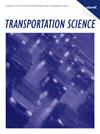对纵向车辆轨迹进行有物理意义的平滑处理的两步二次编程法
IF 4.8
2区 工程技术
Q1 OPERATIONS RESEARCH & MANAGEMENT SCIENCE
引用次数: 0
摘要
由于检测和提取技术的原因,纵向车辆轨迹存在误差和噪声,这对其应用提出了挑战。现有的平滑方法要么缺乏物理意义,要么无法确保解的存在性和唯一性。为解决这一问题,我们提出了一种两步二次编程法,该方法将平滑速度和高阶导数与物理规律、驾驶员行为和车辆特性相一致。众所周知,平滑样条法是在单一二次编程问题中最小化差异和粗糙度的加权和,与此不同,我们的方法将位置误差的先验知识纳入两个连续的二次编程问题中。第 1 步通过最小化半平滑位置与原始位置之间的偏差来求解半平滑位置,但必须符合半平滑位置的速度和高阶导数的物理意义限制。第二步通过最小化粗糙度来求解平滑位置,同时保持物理意义上的界限,并允许平滑位置与原始数据的偏差最多为半平滑位置和先验位置误差的偏差。第二步的系数矩阵不是正定的,因此必须将前几个平滑位置与相应的半平滑位置相匹配,相等约束等于最高阶导数。我们确定了这两个问题的解的存在性和唯一性,确保了其定义明确的性质。使用下一代仿真(NGSIM)数据进行的数值实验表明,三阶导数约束是一种高效的方法,其产生的平滑轨迹与人工重新提取的轨迹相当,符合人体运动的最小挺举原则。与现有方法的比较以及对公路无人机数据集的应用进一步验证了我们方法的有效性。值得注意的是,我们的方法是一种基于轨迹数据的后处理平滑技术,并不针对系统误差。未来的工作将把这种方法扩展到横向车辆轨迹以及人类驾驶车辆和自动驾驶车辆的轨迹预测和规划。这种方法还可用于解决原始数据中已知平均误差的更广泛的平滑问题:本文已被 ISTTT25 会议交通科学特刊接受:作者感谢太平洋西南地区大学交通中心和加州大学交通研究所(UC ITS)全州交通研究计划(STRP)提供的宝贵资金支持。本文章由计算机程序翻译,如有差异,请以英文原文为准。
Two-Step Quadratic Programming for Physically Meaningful Smoothing of Longitudinal Vehicle Trajectories
Longitudinal vehicle trajectories suffer from errors and noise because of detection and extraction techniques, challenging their applications. Existing smoothing methods either lack physical meaning or cannot ensure solution existence and uniqueness. To address this, we propose a two-step quadratic programming method that aligns smoothed speeds and higher-order derivatives with physical laws, drivers’ behaviors, and vehicle characteristics. Unlike the well-known smoothing splines method, which minimizes a weighted sum of discrepancy and roughness in a single quadratic programming problem, our method incorporates prior knowledge of position errors into two sequential quadratic programming problems. Step 1 solves half-smoothed positions by minimizing the discrepancy between them and raw positions, subject to physically meaningful bounds on speeds and higher-order derivatives of half-smoothed positions. Step 2 solves smoothed positions by minimizing the roughness while maintaining physically meaningful bounds and allowing the deviations from raw data of smoothed positions by at most those of the half-smoothed positions and prior position errors. The second step’s coefficient matrix is not positive definite, necessitating the matching of the first few smoothed positions with corresponding half-smoothed ones, with equality constraints equaling the highest order of derivatives. We establish the solution existence and uniqueness for both problems, ensuring their well-defined nature. Numerical experiments using Next Generation Simulation (NGSIM) data demonstrate that a third-order derivative constraint yields an efficient method and produces smoothed trajectories comparable with manually re-extracted ones, consistent with the minimum jerk principle for human movements. Comparisons with an existing approach and application to the Highway Drone data set further validate our method’s efficacy. Notably, our method is a postprocessing smoothing technique based on trajectory data and is not intended for systematic errors. Future work will extend this method to lateral vehicle trajectories and trajectory prediction and planning for both human-driven and automated vehicles. This approach also holds potential for broader smoothing problems with known average error in raw data.History: This paper has been accepted for the Transportation Science Special Issue on ISTTT25 Conference.Funding: The authors extend their gratitude to the Pacific Southwest Region University Transportation Center and the University of California Institute of Transportation Studies (UC ITS) Statewide Transportation Research Program (STRP) for their valuable financial support.
求助全文
通过发布文献求助,成功后即可免费获取论文全文。
去求助
来源期刊

Transportation Science
工程技术-运筹学与管理科学
CiteScore
8.30
自引率
10.90%
发文量
111
审稿时长
12 months
期刊介绍:
Transportation Science, published quarterly by INFORMS, is the flagship journal of the Transportation Science and Logistics Society of INFORMS. As the foremost scientific journal in the cross-disciplinary operational research field of transportation analysis, Transportation Science publishes high-quality original contributions and surveys on phenomena associated with all modes of transportation, present and prospective, including mainly all levels of planning, design, economic, operational, and social aspects. Transportation Science focuses primarily on fundamental theories, coupled with observational and experimental studies of transportation and logistics phenomena and processes, mathematical models, advanced methodologies and novel applications in transportation and logistics systems analysis, planning and design. The journal covers a broad range of topics that include vehicular and human traffic flow theories, models and their application to traffic operations and management, strategic, tactical, and operational planning of transportation and logistics systems; performance analysis methods and system design and optimization; theories and analysis methods for network and spatial activity interaction, equilibrium and dynamics; economics of transportation system supply and evaluation; methodologies for analysis of transportation user behavior and the demand for transportation and logistics services.
Transportation Science is international in scope, with editors from nations around the globe. The editorial board reflects the diverse interdisciplinary interests of the transportation science and logistics community, with members that hold primary affiliations in engineering (civil, industrial, and aeronautical), physics, economics, applied mathematics, and business.
 求助内容:
求助内容: 应助结果提醒方式:
应助结果提醒方式:


